Main menu
Common skin conditions

NEWS
Join DermNet PRO
Read more
Quick links
Linear IgA bullous disease — extra information
Linear IgA bullous disease
Author(s): Hon A/Prof Amanda Oakley, Dermatologist, Hamilton, New Zealand. Updated: Hana Numan, Senior Medical Writer, New Zealand. Copy edited by Gus Mitchell. November 2021.
Introduction Demographics Causes Clinical features Complications Diagnosis Differential diagnoses Treatment Outcome
What is linear IgA bullous disease?
Linear IgA bullous disease is a rare, autoimmune, blistering disease in which blisters form in the skin and mucous membranes including the mouth, genital mucosae, and conjunctivae.
Its name comes from the characteristic findings of linear deposition of immunoglobulin A (IgA) at the dermo-epidermal junction (at the basement membrane zone), which is demonstrated by immunofluorescence. It is also called linear IgA bullous dermatosis and in children, it may be known as linear IgA dermatosis of childhood or chronic bullous disease of childhood.
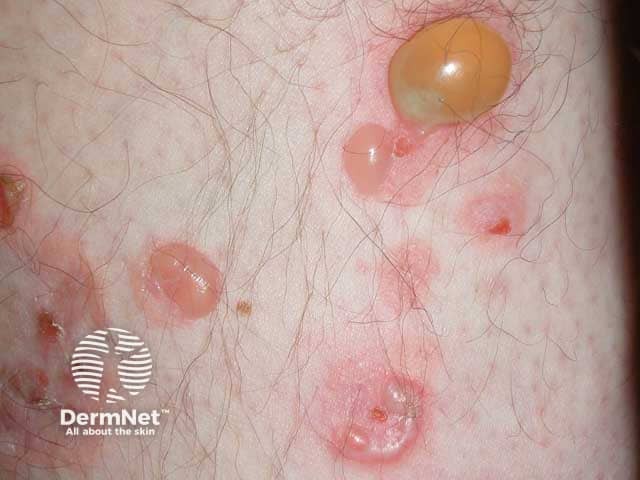
Blisters on the leg in Linear IgA disease
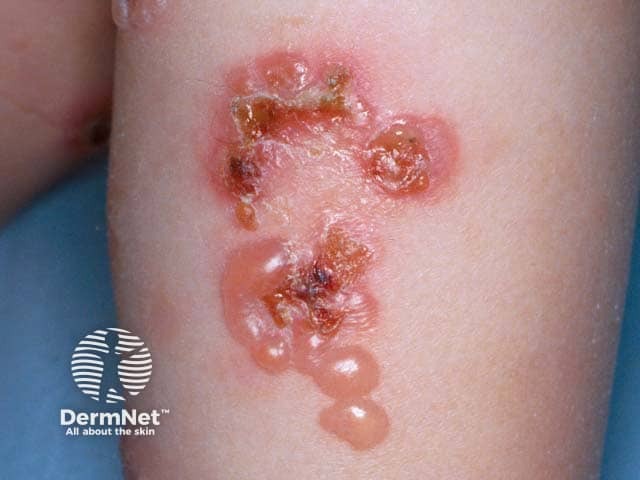
'String of beads' sign in a child with linear IgA disease
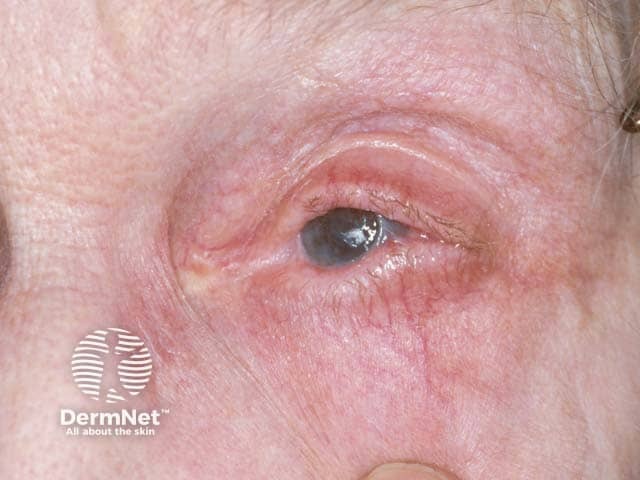
Symblepharon in linear IgA disease
Who gets linear IgA bullous disease?
Linear IgA bullous dermatosis is rare; the annual incidence in some countries is reported to be approximately 0.5–2 cases per million people. It can occur in both adults and children.
In adults, disease onset is more common in the sixth decade. In children, disease onset is more common during preschool age (~4.5 years old).
It has been suggested that it may be more common in children in developing countries.
Linear IgA bullous disease can be associated with some underlying diseases such as inflammatory bowel disease (Crohn, ulcerative colitis), solid and lymphoid malignancies, and rheumatoid arthritis. Unlike dermatitis herpetiformis, where the deposits of IgA on direct immunofluorescence are granular, there is no association with gluten sensitive enteropathy.
Extremely rarely, severe IgA bullous disease develops in the neonatal period, and may progress to produce severe mucosal, aerodigestive lesions, and corneal scarring. It may be due to pathogenic IgA in breast milk, and breast feeding should be discontinued.
What causes linear IgA bullous disease?
Linear IgA bullous dermatitis can be idiopathic or drug-induced. Although it is known to be an autoimmune disease, the exact mechanism of lesion development is not well understood.
Genetic involvement may contribute to the development of chronic bullous disease of childhood where a number of human leukocyte antigen types have been linked.
Drug-induced IgA disease usually resolves on withdrawal of the offending drug. Drugs that may be implicated include:
- Vancomycin (most frequently associated drug)
- Non-steroidal anti-inflammatories eg, diclofenac, naproxen
- Captopril
- Trimethoprim + sulphamethoxazole
- Amiodarone
- Furosemide
- Ciclosporin
- Glibenclamide
- Lithium
- Penicillins
- Cephalosporins (cefalosporins)
- Phenytoin
- Sodium hypochlorite (bleach)
Linear IgA bullous disease may present as toxic epidermal necrolysis (TEN) — a severe cutaneous adverse drug reaction with widespread blistering and painful loss of skin. A few cases have been described in which direct immunofluorescence has revealed characteristic linear deposits of IgA.
Drug-induced TEN-like worsening of linear IgA disease
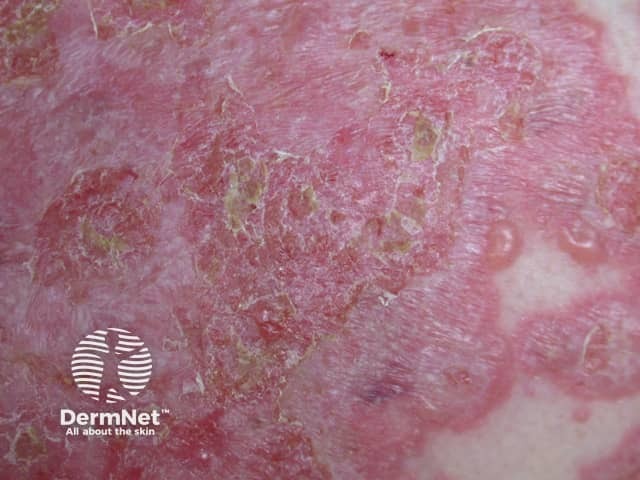
Linear IgA
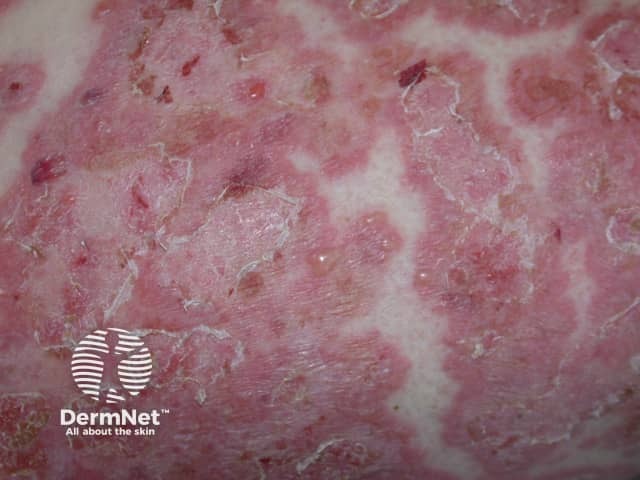
Linear IgA
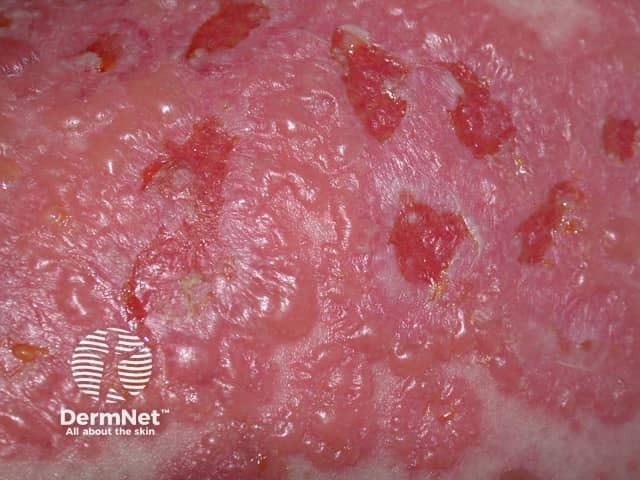
Linear IgA
What are the clinical features of linear IgA bullous disease?
Blisters
- Location:
- May occur anywhere on the body
- In children, usually found on the lower abdomen, thighs, and groin
- In adults, the limbs, face, and trunk are more commonly affected
- Approximately 50% of people have blisters and ulcers on the lips and inside the mouth.
- Presentation:
- Round or oval filled with clear fluid
- Small (vesicles) or large (bullae)
- May arise from normal, red flat, or elevated patches of skin
- Typically found in rings (annular lesions) in children — new blisters tend to arise in a ring around an existing blister known as the ‘string of beads’ sign
- Groups of small blisters may be described as a ‘cluster of jewels’ or ‘crown of jewels’.
Secondary lesions
- Crusts, scratch marks, and sores.
- Lesions seen as inflammation, erosions, ulcers, and scarring may occur along mucous membranes.
Pruritus
- Common
- Intensity of itching varies between individuals
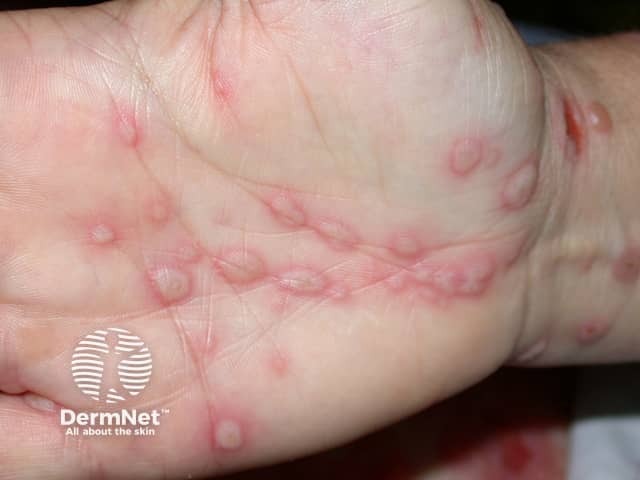
Palmar blisters
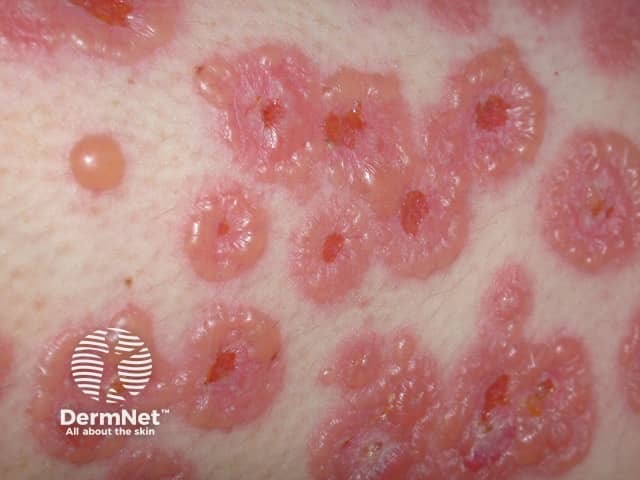
String of beads sign
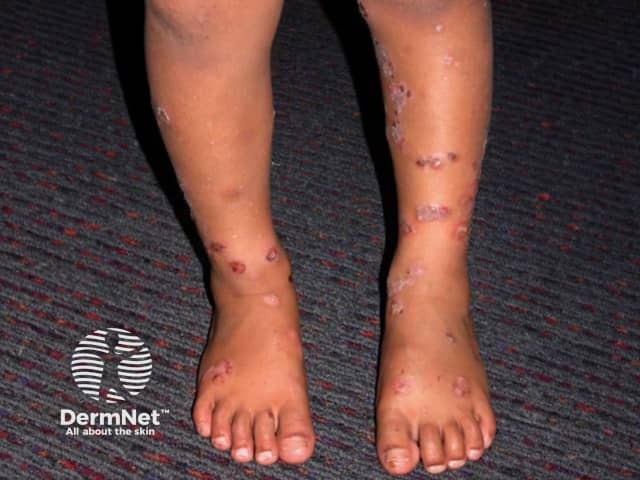
Chronic bullous disease of childhood
What are the complications of linear IgA bullous disease?
Eye involvement may result in irritation, dryness, photosensitivity, blurred vision, corneal scarring, and even blindness.
How is linear IgA bullous disease diagnosed?
History and examination is usually not enough to give a definitive diagnosis as clinical signs and symptoms often resemble other blistering conditions.
Linear IgA bullous disease is best diagnosed by performing direct immunofluorescence of skin adjacent to a blister; it reveals a linear band of IgA at the dermo-epidermal junction.
A thorough medication history should also be taken to determine possible drug aetiology.
Other tests that may be used include:
- Indirect immunofluorescence — IgA antibodies can also be detected by this blood test and may be helpful especially when a biopsy is not possible.
- Light microscopy — however, findings may not be definitive as they may resemble other diseases such as dermatitis herpetiformis.
Direct immunofluorescence in linear IgA bullous dermatosis
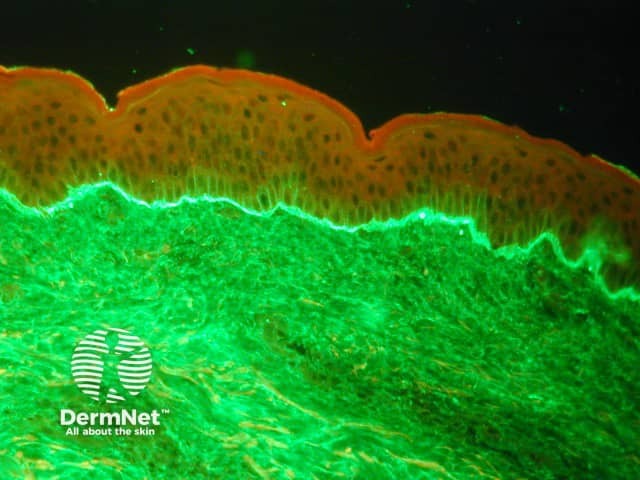
Linear deposit of IgA at the dermoepidermal junction on direct immunofluorescence
What is the differential diagnosis for linear IgA bullous disease?
- Bullous impetigo
- Bullous pemphigoid
- Dermatitis herpetiformis — differentiated by its granular IgA deposition (not linear)
- Epidermolysis bullosa acquisita
- Pemphigoid gestationis
What is the treatment for linear IgA bullous disease?
Linear IgA bullous disease usually improves or clears when treated with dapsone, an immunomodulatory sulphone. Its success as treatment is well-established and improvement can usually be seen within just 2 to 3 days of drug initiation.
Other medications that have been used to treat linear IgA disease include:
- Topical corticosteroids (in some cases, systemic corticosteroids)
- Tetracycline antibiotics
- Erythromycin
- Sulfonamides
- Colchicine
- Mycophenolate mofetil
- Rituximab.
What is the outcome for linear IgA bullous disease?
Linear IgA bullous disease generally has a good prognosis. Approximately 30–60% of adult patients experience spontaneous remission but usually only after years of disease. In children, spontaneous disease remission usually occurs after 2–4 years of disease onset.
However in some patients, long-term treatment may be required if reduction in dose of active treatment results in further blistering.
Drug-induced linear IgA disease has good outcomes where remission occurs in most cases within 2–6 weeks of discontinuation of the offending drug.
Bibliography
- Bernett CN, Fong M, Yadlapati S, Rosario-Collazo JA. Linear IGA Dermatosis. In: StatPearls. Treasure Island (FL): StatPearls Publishing; September 1, 2021. Journal
- Egami S, Suzuki C, Kurihara Y, et al. Neonatal Linear IgA Bullous Dermatosis Mediated by Breast Milk-Borne Maternal IgA. JAMA Dermatol. 2021;157(9):1107-1111. Journal doi:10.1001/jamadermatol.2021.2392
- Kakar R, Paugh H, Jaworsky C. Linear IgA bullous disease presenting as toxic epidermal necrolysis: a case report and review of the literature. Dermatology. 2013;227(3):209–13. doi:10.1159/000353584. Review
- Lammer J, Hein R, Roenneberg S, Biedermann T, Volz T. Drug-induced Linear IgA Bullous Dermatosis: A Case Report and Review of the Literature. Acta Derm Venereol. 2019;99(6):508–15. doi:10.2340/00015555-3154. Journal
- Wiggins CJ, Chon SY. Vancomycin-induced linear IgA bullous dermatosis. Proc (Bayl Univ Med Cent). 2020;34(1):83–4. Published 2020 Aug 26. doi:10.1080/08998280.2020.1809759. PubMed Central
On DermNet
- Linear IgA bullous dermatosis case 1
- Blistering skin conditions
- Blistering diseases
- Drug-induced pemphigus
- IgA pemphigus
Other websites
- Linear IgA Dermatosis — Medscape Reference
- Linear IgA — British Association of Dermatologists
- Australasian Blistering Diseases Foundation
